Documentation – User’s Guide
Sentinel-1 processing with
GAMMA software
Including an example of Sentinel-1 SLC
co-registration and differential interferometry
Version 1.1 – May 2015
GAMMA Remote Sensing AG, Worbstrasse 225, CH-3073 Gümligen, Switzerland
tel: +41-31-951 70 05, fax: +41-31-951 70 08, email: gamma@gamma-rs.ch
�
Sentinel-1 processing with GAMMA software
Table of contents
5.
3.
4.
1.
2.
INTRODUCTION .......................................................................................................................................... 4
S1 STRIPMAP-MODE ................................................................................................................................... 4
2.1. Data import ....................................................................................................................................... 4
2.2. Radiometric calibration .................................................................................................................... 5
2.3. Geocoding ......................................................................................................................................... 5
2.4 Other functionality ............................................................................................................................ 5
S1 TOPS-MODE RAW DATA PROCESSING ................................................................................................... 5
S1 TOPS-MODE GRD DATA PROCESSING .................................................................................................. 6
4.1. Data import ....................................................................................................................................... 6
4.2. Radiometric calibration .................................................................................................................... 6
4.3. Geocoding ......................................................................................................................................... 6
4.4. Offset tracking ................................................................................................................................... 7
4.5 Other functionality ............................................................................................................................ 7
Sentinel-1 Extended Wide-Swath (EWS) GRD products ................................................................... 7
4.6
S1 TOPS-MODE SLC DATA PROCESSING ................................................................................................. 10
5.1. Data import ..................................................................................................................................... 10
5.2. Radiometric calibration .................................................................................................................. 11
5.3. Concatenate consecutive burst SLCs............................................................................................... 12
5.4. Extract selected bursts into a new burst SLC .................................................................................. 12
5.5. Extract data of single bursts into a standard SLC ........................................................................... 12
5.6. MLI mosaic ...................................................................................................................................... 13
5.7.
SLC mosaic...................................................................................................................................... 15
5.8. Azimuth Spectrum Deramping ......................................................................................................... 16
5.9. Geocoding ....................................................................................................................................... 17
Other functionality ...................................................................................................................... 21
5.10
S1 TOPS-MODE INTERFEROMETRY ......................................................................................................... 22
6.1. TOPS SLC co-registration............................................................................................................... 22
6.2. TOPS SLC co-registration using script S1_coreg_TOPS ............................................................... 28
6.3. TOPS SLC Interferometry ............................................................................................................... 30
S1 TOPS-MODE PERSISTENT SCATTERER INTERFEROMETRY (PSI) ......................................................... 32
7.1. Basic PSI strategy ........................................................................................................................... 32
7.2.
Investigating burst overlap regions ................................................................................................. 33
S1 TOPS-MODE OFFSET TRACKING ........................................................................................................ 34
8.1. Basic offset tracking strategy .......................................................................................................... 34
Investigating burst overlap regions ................................................................................................. 35
8.2.
S1 TOPS-MODE SPLIT-BEAM INTERFEROMETRY ..................................................................................... 36
Split-beam interferometry within bursts .......................................................................................... 36
Split-beam interferometry between bursts ....................................................................................... 36
10. ADDING OPOD PRECISION STATE VECTORS ............................................................................................. 37
11. REFERENCES ............................................................................................................................................ 37
9.1.
9.2.
6.
7.
8.
9.
- 2 -
�
Sentinel-1 processing with GAMMA software
List of acronyms
DEM
DIFF&GEO
ESA
IPTA
ISP
IWS
LAT
MLI
MSP
PRF
SAR
S1
SLC
SRTM
TOPS
Digital Elevation Model
Differential Interferometry And Geocoding Software
European Space Agency
Interferometric Point Target Analysis
Interferometric SAR Processor
Interferometric wide-swath mode
Land Application Tools
Multi-Look Intensity
Modular SAR Processor
Pulse Repetition Frequency
Synthetic Aperture Radar
Sentinel-1
Single Look Complex
Shuttle Radar Topography Mission
Special SAR acquisition mode of Sentinel-1 [3]
Change record
V1.0 – Oct. 2014
V1.1 – May 2015
Initial version
Importing of GRD products was modified to convert the ground-range data directly to the
slant range geometry considering the temporally interpolated gr(sr) polynomials available
in the metadata.
SCOMPLEX format for the S1 IWS SLC data is supported (besides FCOMPLEX).
SLC_cat_S1_TOPS was added to concatenate S1 IWS SLC data.
S1_coreg_overlap was updated (supporting the estimation of the azimuth offset refinement
using a spectral diversity method considering double difference interferograms in the burst
overlap region)
S1_subswath_coreg_overlap was added supporting the estimation of the azimuth offset
refinement using a spectral diversity method considering double difference interferograms
in the burst sub-swath overlap region
S1_coreg_TOPS was added to supporting the S1 IWS co-registration sequence using co-
registration refinements based on matching and spectral diversity.
S1_poly_overlap was added supporting the calculation of polygons for the IWS burst
overlap regions
S1_deramp_TOPS_reference was added to deramp a S1 IWS reference.
S1_deramp_TOPS_slave was added to deramp a S1 IWS co-registered slave.
Using OPOD state vectors is supported using the program S1_OPOD_vec
- 3 -
�
Sentinel-1 processing with GAMMA software
1.
Introduction
In this document the support provided in the GAMMA Software for the processing of
Sentinel-1 (S1) data is summarized. In particular the use of S1 TOPS mode [3] SLC data for
interferometric processing is described in detail as this is significantly different from
interferometric processing using strip map mode data.
The basic approach followed is that S1 TOPS mode burst SLC can be imported ( burst SLC
data file and related parameter files). The burst SLC can be detected and mosaiced to get a
“mosaic MLI” that includes multiple bursts (along track) and multiple sub-swaths (cross.-
track). Similarly, a “mosaic SLC” can be generated – which has the advantage that much of
the existing functionality throughout the GAMMA Software can readily be used. To be able
to use this approach it is important that the burst SLC geometry is using consistent geometric
parameters (including the sampling in slant range and azimuth) between the bursts and
between sub-swaths. This aspect was carefully checked and the data was found to meet this
requirement.
What is supported with a newly implemented program specifically adapted to the TOPS
characteristics is a program for the resampling of a burst SLC to the geometry of a reference
burst SLC. In the preparation of the reference and slave burst SLC the programs to
concatenate burst SLCs and to copy out a set of indicated bursts from a burst SLC are used to
assure that the corresponding bursts are included for the master and the slave.
In addition, a program to extract a single burst of a burst SLC and to write it out as a standard
SLC with the corresponding SLC parameter file was implemented as a tool for testing and to
provide additional flexibility, e.g. to investigate data in the overlap regions between bursts
and sub-swaths.
Furthermore, new programs to deramp SLC and burst SLC data for the azimuth phase ramp
related to the variation of the Doppler Centroid were included.
Finally, some typical processing sequences and tests conducted are described. For this we
used real Sentinel-1A TOPS mode data that we had available from ESA. To do interferometry
with S1 TOPS mode data extremely high co-registration requirements have to be met [4]. In
azimuth direction a co-registration accuracy of 0.001 SLC pixel is required to reduce the
phase jumps at the burst interface to 3 deg. [4]. Such accuracies can be achieved by
considering the double difference phase of the burst overlap areas [5].
The new functionality described is found in the ISP and DIFF&GEO modules.
2. S1 stripmap-mode
2.1. Data import
Sentinel-1 stripmap mode data is imported using the same programs as used for the TOPS
data import:
par_S1_SLC is used to import SLC data
par_S1_GRD is used to import GRD (detected data in ground-range geometry)
Apart from the GEOTIFF data file xml files containing metadata, calibration information, and
noise information are indicated. As output the program generates the SLC or GRD file the
corresponding parameter file.
- 4 -
�
Sentinel-1 processing with GAMMA software
In the metadata the ground-range geometry is characterized with polynomials expressing the
ground-range as a function of the slant range (as well as polynomials expressing the slant
range as a function of the ground-range). In azimuth direction multiple such polynomials are
available. According to the documentation linear interpolation (in time) can be used to get the
polynomial for a time between two polynomials. In the ground-range format used in the
GAMMA software it is only foreseen to include 3 such polynomials (for the start, center and
end time). In the GRD production more polynomials are used and the polynomials are
updated over time also considering topographic height information. In order not to degrade
the geometry we decided therefore to directly convert the ground-range products to slant
range geometry when importing it.
The quality of the imported multi-look intensity (MLI) data files generated from GRD
products was checked against SLC data based MLI products and found to be corresponding to
mm scale – which is clearly not the case when directly using the imported ground-range
products without applying the transformation polynomials.
2.2. Radiometric calibration
In the reading of the SLC and GRD data the radiometric calibration procedure is applied, so
that the imported values correspond to backscattering intensities (also for the GRD data it is
intensities and not amplitudes!). For the S1 calibration and noise files are used to apply the
procedures as described in S1 reference documents.
2.3. Geocoding
Geocoding of S1 stripmap mode data is as for all other sensors. Concerning the quality of the
state vector our experience is as follows:
For SLC data the geocoding is almost perfect even without refinement. The refinement
determined is usually very small and applying a constant offset is usually sufficient and
therefore preferred over refining with linear or quadratic offset polynomials.
For GRD data the geocoding quality achieved based on the state vectors and DEM is also of
high quality. It is strongly recommended to do all further steps after the importing using the
MLI image in slant-range geometry generated by par_S1_GRD . Working with the imported
data in ground-range geometry is not recommended because of the reduced geometric
accuracy achieved (only 3 ground-range polynomials are stored in the GRD parameter file).
2.4 Other functionality
After the import the S1 stripmap mode data are in the normal SLC or MLI (or GRD) format
used in the GAMMA software, making all functionality of the software available.
3. S1 TOPS-mode raw data processing
So far the GAMMA Software does not include a Sentinel-1 raw data processor.
Before October the data available was SLC or GRD data. Then, quite unexpectedly raw data
became available (besides GRD data and very few SLC data). In the meantime it is again
more SLC data becoming available.
- 5 -
�
Sentinel-1 processing with GAMMA software
Once the data distribution strategy becomes clearer we will decide if we will implement a
TOPS mode data processor for Sentinel-1 as part of the GAMMA Software.
4. S1 TOPS-mode GRD data processing
4.1. Data import
Sentinel-1 GRD (ground-range) data is detected data that was converted to ground-range
azimuth geometry. In the reading the calibration procedure is applied, so that the imported
values correspond to backscattering intensities (and not amplitudes).
In the slant-range to ground-range conversion ESA applies polynomials which are provided in
the meta data. In the calculation of these polynomials a topography model was considered in
addition to the orbit data. Consequently the geometry of the GRD products does not fully
correspond to the GRD geometry assumed in the GAMMA Software. Furthermore, offsets
between two GRD images depend on the transformation applied, which sometime varies
between scenes over the same area.
To avoid problems with the geometry of the GRD products we decided to directly convert the
GRD products back to the slant range geometry. The converted data corresponds to a multi-
look intensity image. Its geometry is specified in the related MLI parameter file. Optionally,
e.g. for testing purposes, the GRD data can also be written out in the GRD geometry.
To read in the Sentinel-1 GRD (ground-range) data the program par_S1_GRD is used:
par_S1_GRD s1a-iw-grd-hh*.tiff s1a*hh*.xml calibration-s1a-iw-grd-hh-*.xml noise-s1a-iw-grd-hh-
*.xml 20140502.hh.mli.par 20140502.hh.mli
Apart from the GEOTIFF data file xml files containing metadata, calibration information, and
noise information are indicated. As output the program generates the MLI file 20140502.hh.mli
and the corresponding parameter file 20140502.hh.mli.par. The GRD product is directly
converted to the slant range geometry. Furthermore radiometric calibration is applied.
The geometry of the MLI image was tested against the geometry of an MLI image generated
from the corresponding SLC product. The geometries were found to be identical at dm scale.
An important advantage of this transformation is that the GRD data can be geocoded at high
precision and they can be used well for offset tracking.
An example of an MLI file based on dual pol. TOPS GRD data is shown in Figure 1.
4.2. Radiometric calibration
In the reading of the GRD data the radiometric calibration procedure is applied (respectively
the GRD product is already calibrated considering both the calibration and noise data), so that
the imported MLI values correspond to backscattering intensities (sigma-zero values using the
ellipsoid area as reference area) in slant range geometry.
4.3. Geocoding
To geocoded Sentinel-1 GRD products it is highly recommended to use the imported multi-
look intensity image in slant range geometry (and not the ground-range product that can also
- 6 -
�
Sentinel-1 processing with GAMMA software
be generated). The geocoding is done using the program gc_map (and not gc_map_grd which
would be for data in ground-range geometry).
For GRD data products the geocoding quality achieved based on the state vectors and DEM is
of the same high quality as for the SLC products. Note that typically meter scale quality is
achieved even without refinement of the geocoding lookup table.
4.4. Offset tracking
for offset
TOPS mode S1 GRD products can be used
(program
offset_pwr_trackingm) to map displacements. For this it is highly recommended to use the
imported multi-look intensity image in slant range geometry (and not the ground-range
product that can also be generated which may result in anomalies in the offset field). In order
to apply a co-registration of the data considering the terrain topography before the
determination of the offsets it is recommended to use the co-registration procedure using
rdc_trans. Furthermore, supportive programs e.g. to calculate the look vector direction or to
convert the LOS displacement component to other components are available for the MLI in
slant range geometry.
tracking
As compared to offset tracking with SLC data a reduced quality is expected for the range
offsets because of the multi-looking applied in the generation of the GRD products.
Nevertheless, this may be acceptable as the quality of the range offsets will still be higher than
the quality of the azimuth offsets.
Considering that the GRD and SLC product based MLI geometries are identical means that it
is also possible to do offset tracking between a GRD product and an SLC product.
4.5 Other functionality
After the importing, the GRD data (even if acquired in TOPS mode) is in the normal MLI
slant range geometry and format used in the GAMMA software, making all functionality of
the software available (e.g. multi-temporal analysis or terrain correction of backscattering
coefficients using the pixel_area approach).
4.6 Sentinel-1 Extended Wide-Swath (EWS) GRD products
The functionality for Sentinel-1 GRD products is also applicable for the Sentinel-1 Extended
Wide-Swath (EWS) GRD products. An example of a geocoded S1 EWS offset field over
Svalbard is shown in Figure 2. The result confirms that EWS GRD products can be used for
offset tracking, nevertheless the quality of the results is lower than for IWS data because of
the lower spatial resolution.
- 7 -
�
Sentinel-1 processing with GAMMA software
S1-TOPS GRD HH-pol. image 20140502 over
Jena, Germany
Small section of S1-TOPS GRD HH-pol.
image 20140502 over Jena, Germany
Small section of S1-TOPS GRD HV-pol.
image 20140502 over Jena, Germany
Small section of RGB composite of HH-pol
(red) HV-pol (green and blue) HV-pol. image
20140502 over Jena, Germany
S1-TOPS GRD HH-pol. image 20140502 over Jena, Germany, geocoded to geographic
coordinates).
Figure 1 Images derived from dual-pol. S1-TOPS GRD image, 20140502 over Jena, Germany
- 8 -
�
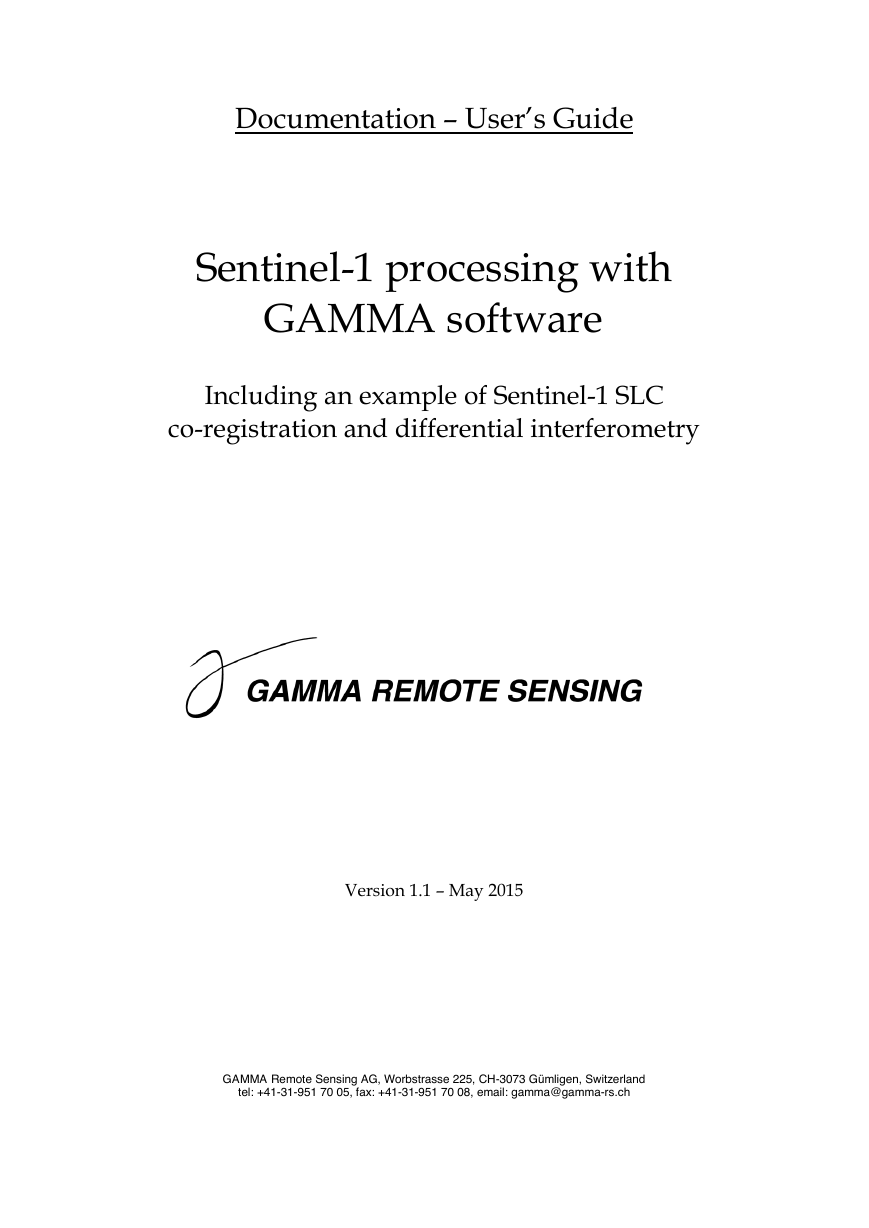
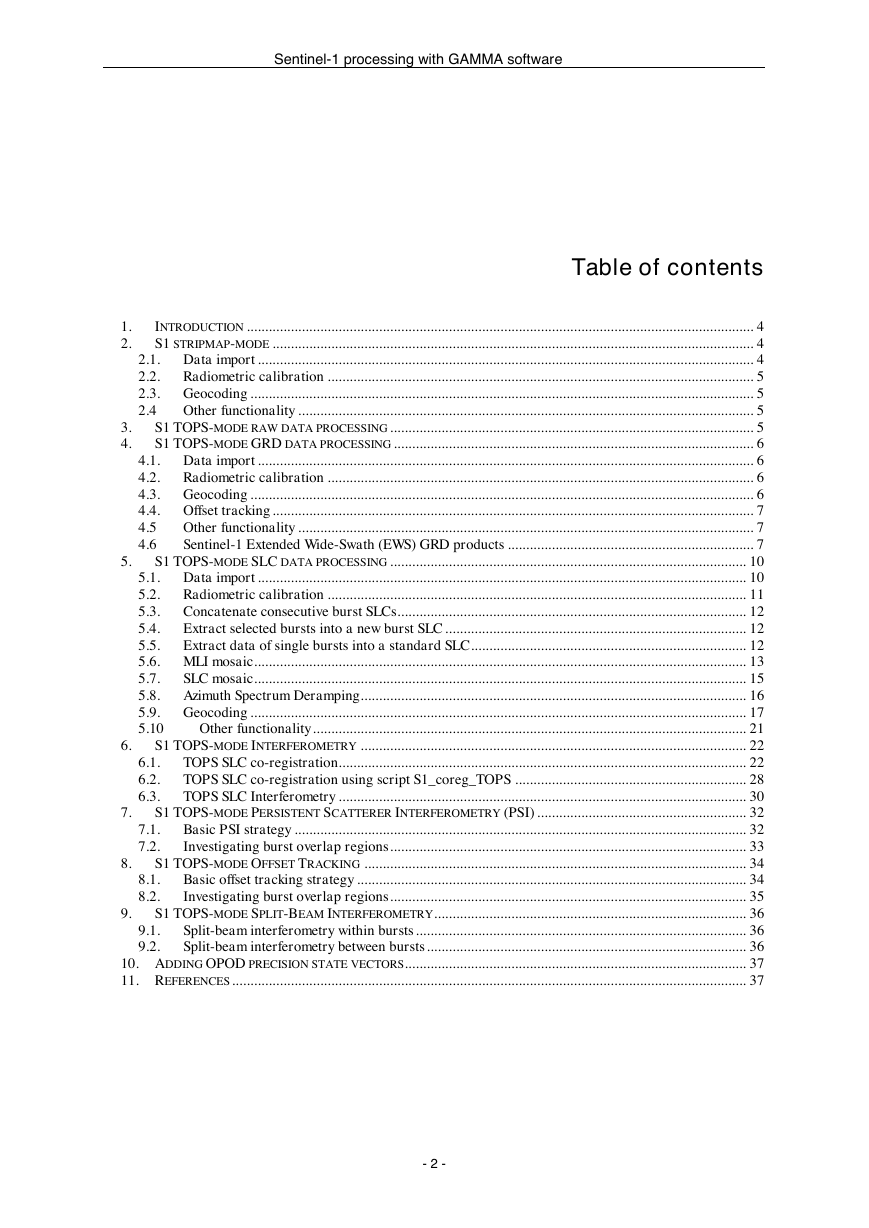
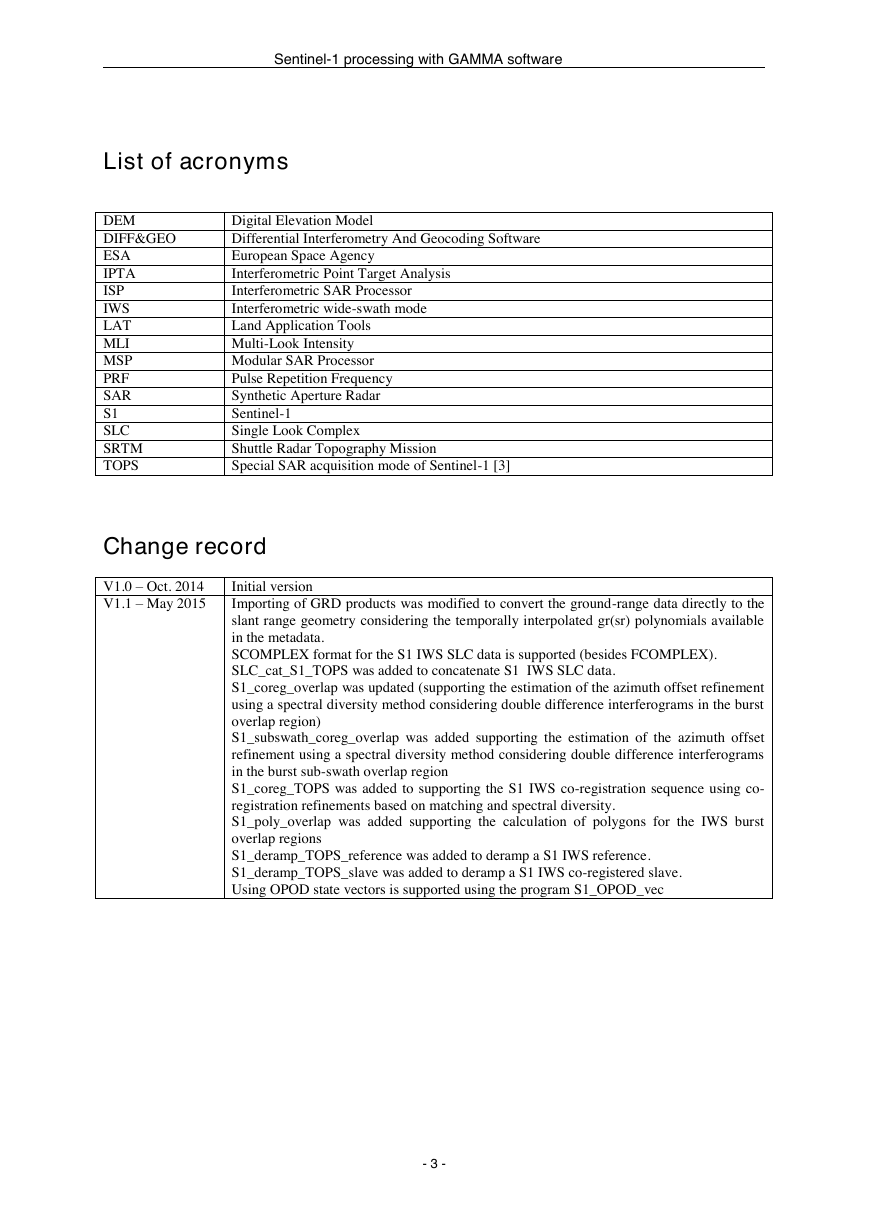
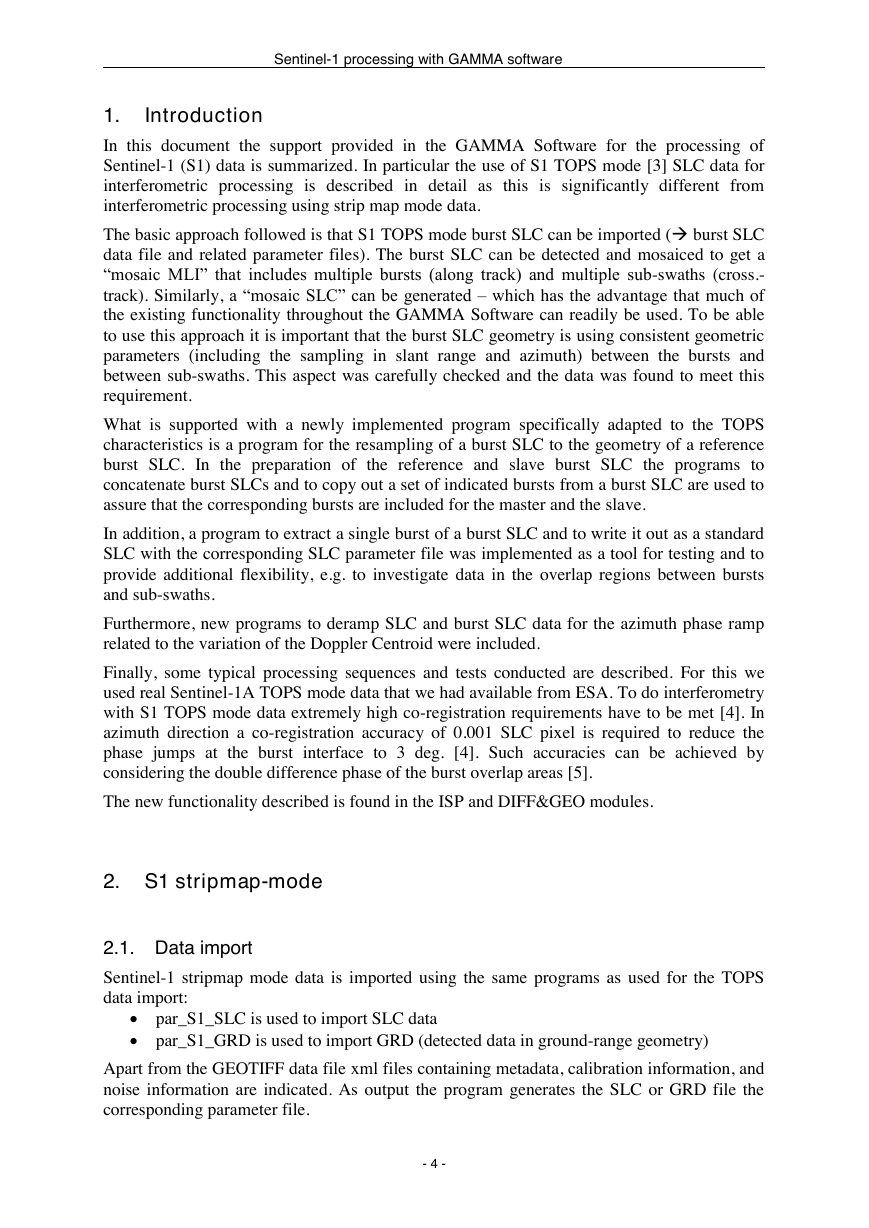
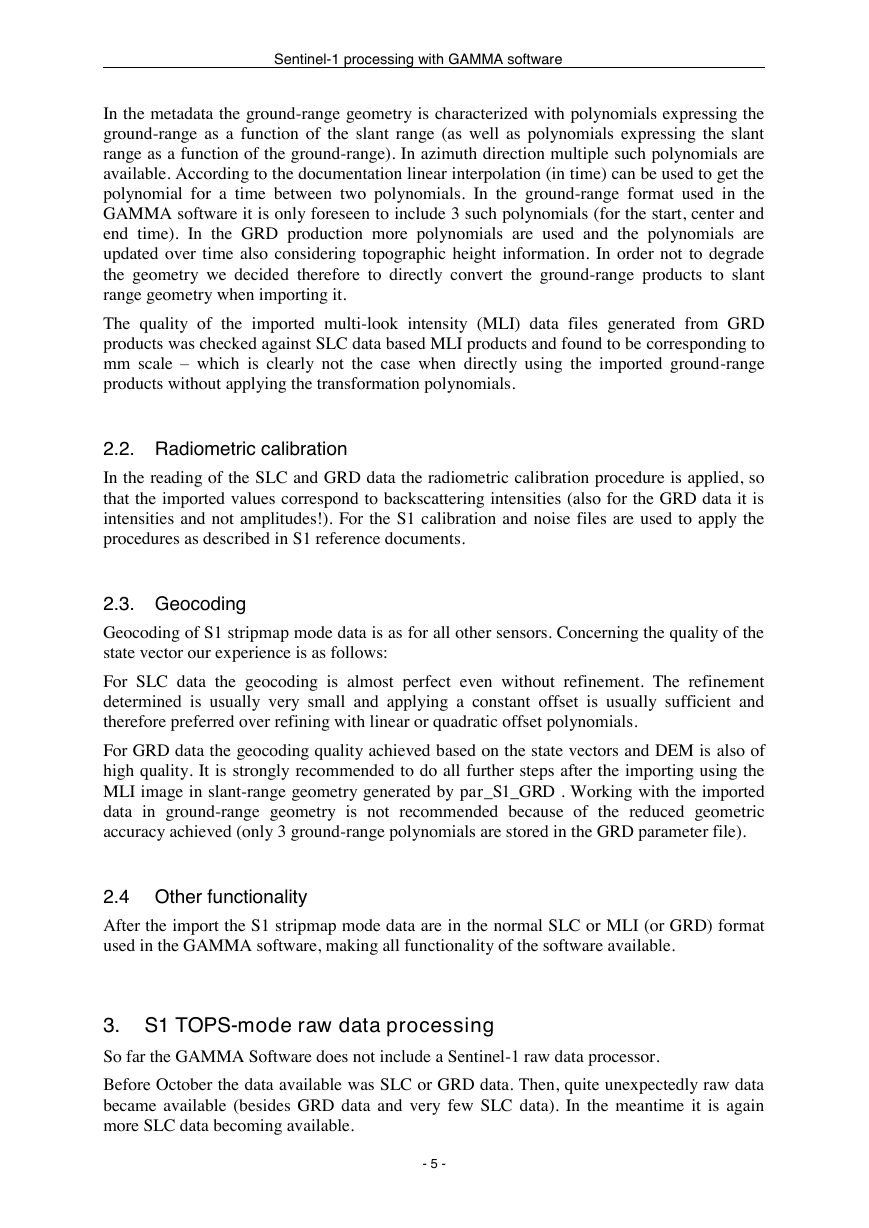
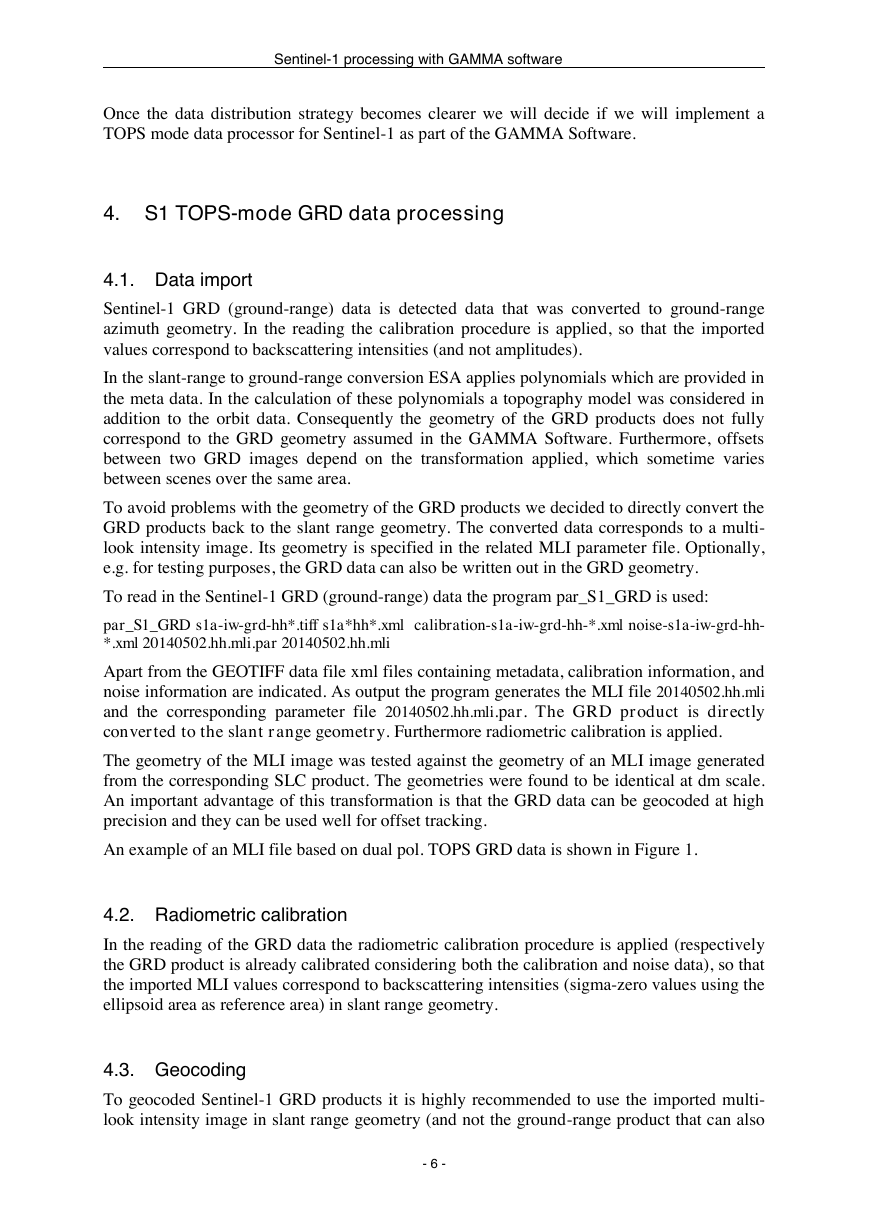
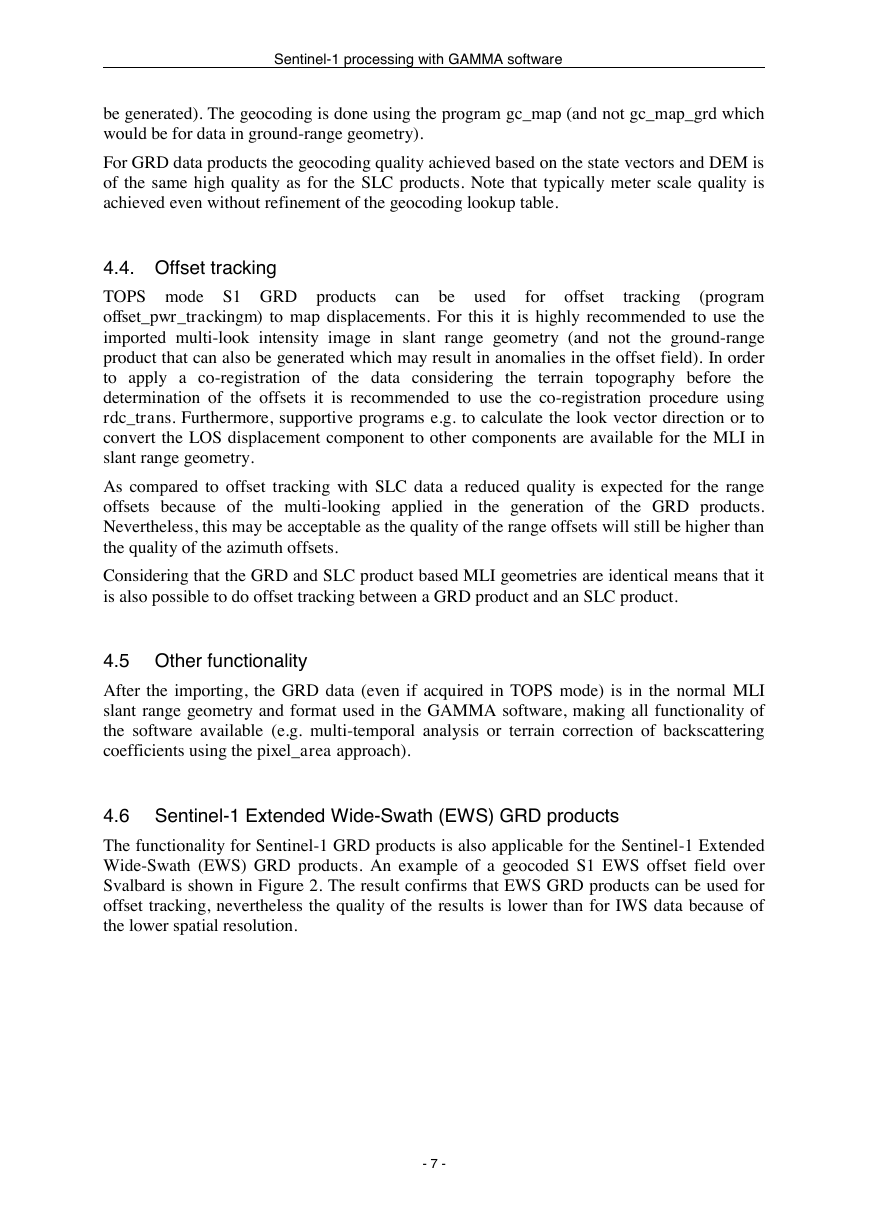









 2023年江西萍乡中考道德与法治真题及答案.doc
2023年江西萍乡中考道德与法治真题及答案.doc 2012年重庆南川中考生物真题及答案.doc
2012年重庆南川中考生物真题及答案.doc 2013年江西师范大学地理学综合及文艺理论基础考研真题.doc
2013年江西师范大学地理学综合及文艺理论基础考研真题.doc 2020年四川甘孜小升初语文真题及答案I卷.doc
2020年四川甘孜小升初语文真题及答案I卷.doc 2020年注册岩土工程师专业基础考试真题及答案.doc
2020年注册岩土工程师专业基础考试真题及答案.doc 2023-2024学年福建省厦门市九年级上学期数学月考试题及答案.doc
2023-2024学年福建省厦门市九年级上学期数学月考试题及答案.doc 2021-2022学年辽宁省沈阳市大东区九年级上学期语文期末试题及答案.doc
2021-2022学年辽宁省沈阳市大东区九年级上学期语文期末试题及答案.doc 2022-2023学年北京东城区初三第一学期物理期末试卷及答案.doc
2022-2023学年北京东城区初三第一学期物理期末试卷及答案.doc 2018上半年江西教师资格初中地理学科知识与教学能力真题及答案.doc
2018上半年江西教师资格初中地理学科知识与教学能力真题及答案.doc 2012年河北国家公务员申论考试真题及答案-省级.doc
2012年河北国家公务员申论考试真题及答案-省级.doc 2020-2021学年江苏省扬州市江都区邵樊片九年级上学期数学第一次质量检测试题及答案.doc
2020-2021学年江苏省扬州市江都区邵樊片九年级上学期数学第一次质量检测试题及答案.doc 2022下半年黑龙江教师资格证中学综合素质真题及答案.doc
2022下半年黑龙江教师资格证中学综合素质真题及答案.doc